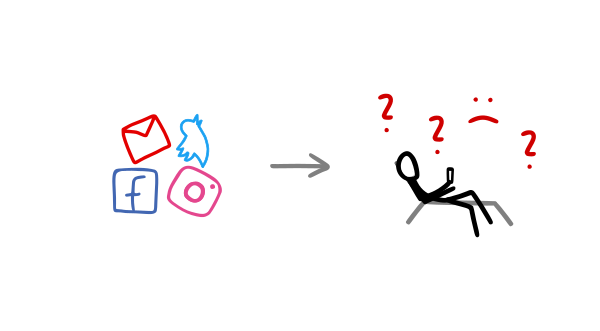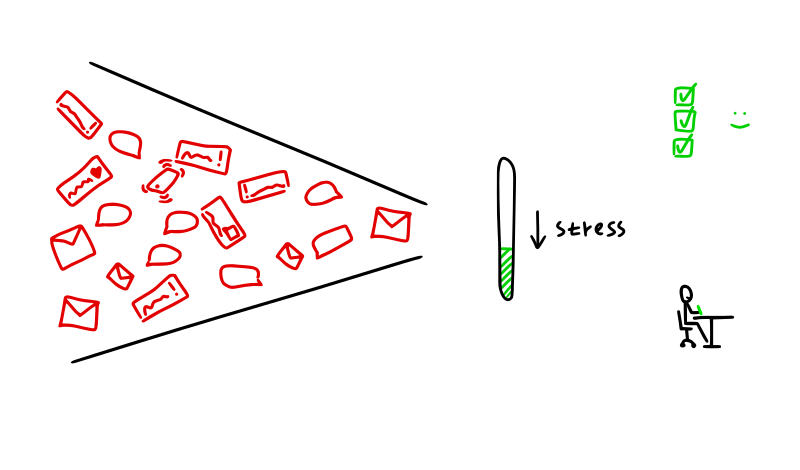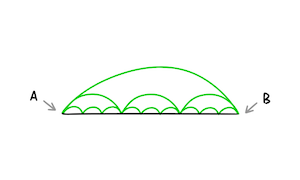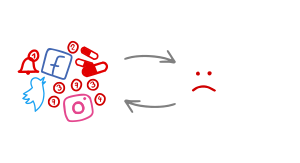How the Internet can cause ADHD-like symptoms

Why is my mind scattered?
Why do I always lose track of the path even though I knew it was so important?
Why do I feel so overwhelmed?
Why can’t I follow through with things?
We’ve been writing about addiction for the last few months and all the puzzle pieces about why so many modern technology users struggle are falling into place.
Modern technology can cause ADHD-like symptoms which then increase the likelihood of us being addicted to things like social media, video games, smartphones.
It’s yet another argument for learning to tame this beast called the Internet.
It all goes back to dopamine
The current most supported explanation of ADHD is the low dopamine hypothesis. [1]
People with ADHD are supposed to have a low dopamine baseline.
When the brain is in a low dopamine state - neurons that regulate our attention fire much more and we get distracted easily.
Contrary to popular opinion, people who have ADHD can experience laser focus, but only when they find something that releases a lot of dopamine: Drugs, an interesting problem to solve, video games...
When you’re in a high dopamine state - your vision and hearing become narrow - you’re able to ignore both internal distractions (distracting thoughts, worries) and external ones (repetitive sounds - cars passing by).
This is even stronger for people with ADHD because the state of high dopamine feels like bliss. That’s why when we find something that gives us a lot of dopamine, we have trouble restraining ourselves from it.
However, as we’ve written here, being in a high dopamine state for prolonged periods of time causes your brain to get desensitized to dopamine.
So that means that if you spend a lot of time on your phone, watching porn, browsing the Internet, playing video games - your brain becomes desensitized.
Your dopamine baseline becomes lower than usual… You get distracted much more easily, your impulse control goes down - exactly what ADHD sounds like.
To add to this mix, modern technology primes us to switch context a lot (look at how many browser tabs you have open and how many apps you switch in between on your phone). It becomes clear why it’s so difficult to focus on non-shiny things like books, lectures, or meetings at work.
It becomes a vicious cycle
People who are in a ADHD-like state fail to complete tasks, move forward in life and this causes shame. Self-image and self-esteem plummet. This makes them even less able to be alone with their thoughts and look frantically for the next shiny thing.
It creates this vicious cycle:
Overstimulating your brain with dopamine (phone, porn, internet, drugs) → lower dopamine baseline → more difficult to not get distracted (ADHD-like) → not completing things and being disorganized → feelings of shame → lower self-esteem → reality is unbearable = more prone to stress, anxiety, addiction, and depression.
Getting out of this vicious cycle can be hard.
Because nowadays, you have access to constant stimulation via the Internet 24/7. We cover here why the Internet and smartphones are something unprecedented.
This might explain why so many young people struggle to actualize themselves (whatever that is - meaning, career, family, relationships, friendships). It’s difficult to actualize yourself when your brain is so disorganized.
When reality is unbearable - everyone answers differently to this challenge.
Some people escape via addiction to cope. Some people become more stressed and anxious. Others become depressed.
And the numbers don’t lie, because 50% of people with ADHD also have substance use disorder (addiction to substances like alcohol, nicotine, or drugs) [2]
These statistics don’t include behavioral addictions, so the percentages are probably even higher.
In an ADHD-like state, you’re more likely to get addicted because your regular unstimulated state (= boredom, ordinary life) becomes unbearable.
That doesn’t mean you have ADHD
You might be thinking: Doesn’t everyone have ADHD?
It’s a valid question because almost everyone now shows signs of ADHD in today’s society.
It might be our brain’s natural way to deal with information overload, current societal and technological problems. It might be the only way our brains are able to survive, process it, and move on. It might be.
They called ADHD “flavor of the nineties” because of how “hectic” it was supposed to be. Since then, the modern world has become much more hectic.
If this is the brain’s natural response to this new environment, then ADHD isn’t a disease anymore but it’s more of a trait. A trait that we can use to our advantage when we learn how to deal with it. It comes with immense creativity, the ability to hyperfocus when we find something interesting.
Of course to be able to tap into this power, we need to be able to function properly. That means that either we have to alleviate the ADHD symptoms, or we have to redirect our attention to things we like and are good for us (choose your addiction). We learn how to work around it.
If everyone’s brain is more ADHD-like then the interventions are suited for everyone.
Of course, if you feel your signs of ADHD are much worse than the average population, go look for professional help.
In severe cases, temporary medication and working with a psychotherapist can help you immensely. It’s nothing to be ashamed of.
It can actually be quite relieving to find out, although diagnosis shouldn’t serve as an excuse or put you in a victim role.
Summary
Modern environment produces ADHD symptoms in many of us because it can make our dopamine baseline low, which is highly related with ADHD. This also explains why we become addicted to distractions: because the opposite of state (= low dopamine = boredom) is intolerable to us when we’re used to prolonged high dopamine states.
The combo of ADHD + addiction to distractions makes it really frustrating when we try to change, moderate our behavior, or control ourselves to achieve our goals in life, whatever that may be.
However, hiding your head in the sand won’t solve the issue for you.
The good news is this process appears to be reversible.
How?


